Apple's iPhone 4: Thoroughly Reviewed
by Brian Klug & Anand Lal Shimpi on June 30, 2010 4:06 AM EST- Posted in
- Smartphones
- Apple
- iPhone 4
- Gadgets
- Mobile
I'm not sure how this keeps happening. The first year I waited at a mall for 5 hours to get the original iPhone. The following year my friend Mark Rein convinced me to see a midnight showing of Hellboy II and then wait outside of an AT&T store all night to get the iPhone 3G. You'd think I'd learn by the third year but once more I was in line at the mall hours before the Apple store opened to get the 3GS. This year I thought it would be different. Apple offered free overnight shipping to anyone who wanted to pre-order the iPhone 4. Figuring everyone would go that route I decided to beat the FedEx trucks and just show up at the mall at 6AM. I'd be in and out in a little over an hour, which would give me a head start on battery life testing on Apple's 4th generation iPhone.
I promise that not all of my decisions play out this poorly. Those who pre-ordered the 4 and requested overnight delivery got their phones early and my one hour wait turned into six hours at the mall, for the fourth year in a row.
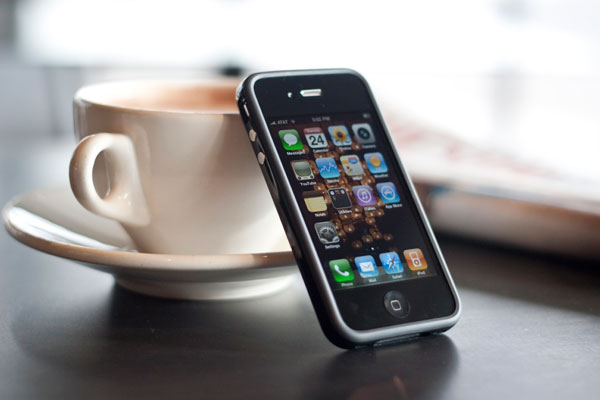
Apple's iPhone 4 with Bumper Case
It's a self fulfilling prophecy. Steve gets up on stage, proclaims the iPhone 4 to be the biggest introduction since the original iPhone, and the public flocks to Apple stores to fork over $200 on day one and around $2500 over the course of two years for the privilege. But this isn't 2007. Apple has real competitors in the smartphone space. Android phones have grown in features, polish and popularity. Even Palm entered the race with a competant offering, and Microsoft isn't far behind. It's easy to start a revolution when everyone else is doing the wrong thing, but what about when more companies actually get it? Was Steve justified in his excitement over the 4? That's what we're here to find out today.
Straight on it looks like just another iPhone. You get the black face with a shiny trim. From the side it is the redesign that Apple has needed for a while now. It’s not revolutionary but it’s the type of improvement that makes its predecessor feel old. And that’s exactly what this does. Have a look for yourself:
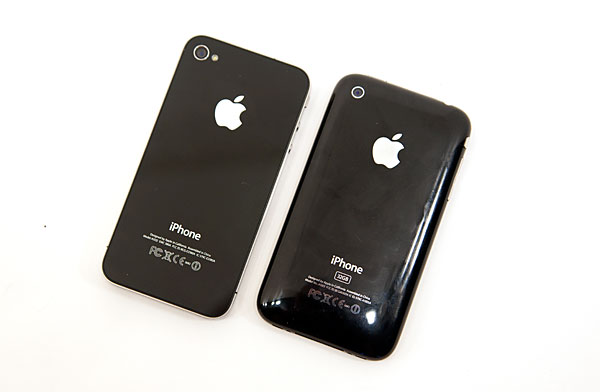
iPhone 4 (left) vs. iPhone 3GS (right)
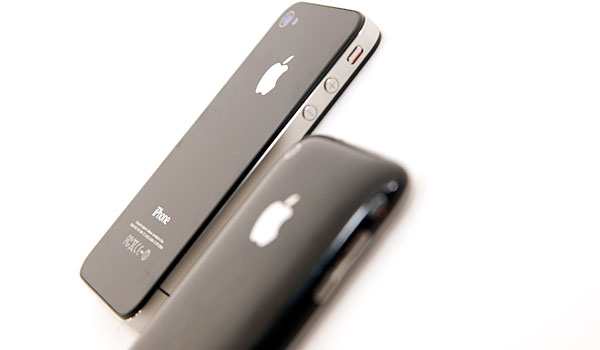
The straight lines, smaller dimensions and lack of unnecessary bulk make the 3GS feel like a car from the 90s, unnecessarily curvy. The styling is now so much more compact. Compared to the iPhone 3GS the 4 is around 5% narrower (but no more difficult to type on) and nearly 25% thinner. It even makes the Nexus One look dated:
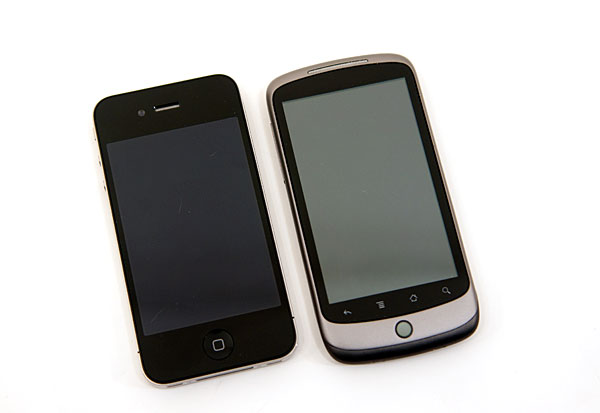
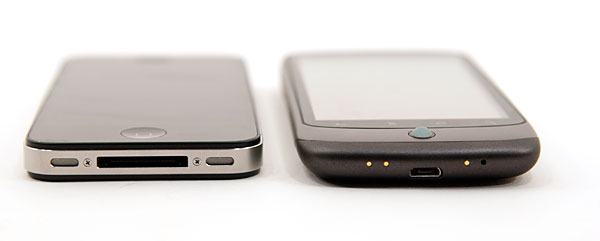
The iPhone 4 is slightly heavier than the 3GS (4.8oz vs. 4.7oz). You feel the added weight but I wouldn't call it heavy. The front and the back of the iPhone 4 are both made out of glass, and they protrude beyond the stainless steel band that wraps around the phone (more on this controversial decision later). While this gives the 4 an amazing finish, it also makes carrying the phone nerve racking. Coupled with the smaller, more dense form factor I’m now deathly afraid of dropping and shattering this thing. Apple has done a lot to reinforce the glass, however there have been enough reports already of shattered iPhone 4s for me not to feel very safe. Only Apple would think to make the two surfaces most likely to hit something out of glass. It's like making mouse traps out of cheese, something bad is bound to happen.
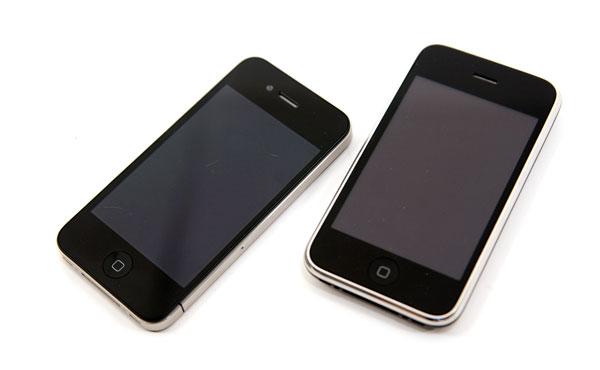
iPhone 4 (left) vs. iPhone 3GS (right)
The physical buttons (but not their layout) have changed on the 4. The ringer switch has shorter travel and feels sturdier as a result. The volume rocker has been replaced by discrete volume up/down buttons, also very sturdy in feel. The power/lock button is also now made out of stainless steel. Only the home button remains unchanged, although it does seem to make a deeper click when you use it.

The speaker moved to behind the right grill at the bottom of the phone instead of the left. The dock connector thankfully remained unchanged. It looks like Apple is committed to maintaining this connector until it makes the jump to something wireless (or optical?).

The back of the phone is pretty. Apple broke with tradition and finally included a single LED flash on the phone. The flash comes on in low light conditions and is enough to take shots in total darkness.
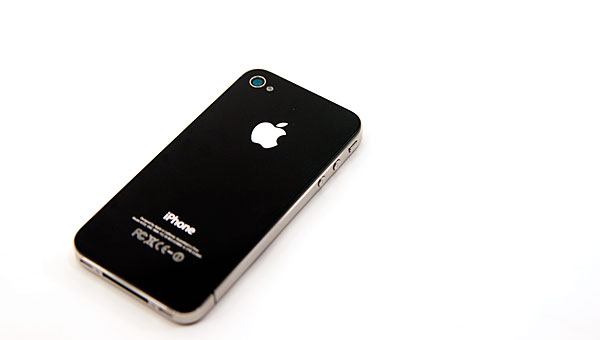
The camera has been upgraded to a low noise 5MP sensor. It can shoot stills at up to 2592 x 1936 or video at 1280 x 720 @ 30 fps. We’ll go into greater detail on its quality in the camera section. The iPhone 4 also adds a front facing camera capable of shooting both photos and video at 640 x 480.
Apple quotes contrast ratio as 1000:1, in our measurements we got very close (952:1). A significant improvement over the 188:1 ratio of the 3GS. Apple achieved this by both dropping black levels and increasing the white levels on the display. Improving both is always fine by me.
Internally the iPhone 4 uses Apple's new A4 SoC, built around an ARM Cortex A8 CPU and a PowerVR SGX GPU. The new SoC is built on a 45nm process and features 512MB of memory on the package. Apple hasn't made CPU clock speed public, but I'm guessing around 800MHz compared to the iPad's 1GHz for reasons you'll see later. GPU clock speed is unknown as well. Having more memory on package is an interesting move by Apple as it makes the iPhone 4 better suited for multitasking compared to the iPad. Also implying that shortly after the iPad gets multitasking it'll be updated to a version with more memory as well.
The iPhone now has an gyroscope as well the rotation sensors of its predecessors. Developers are given full access to the gyroscope making the iPhone 4 capable of becoming a very expensive Wii-mote.
| Physical Comparison | ||||||||
| Apple iPhone 4 | Apple iPhone 3GS | HTC EVO 4G (Qualcomm Snapdragon QSD8650) | HTC Droid Incredible (Qualcomm Snapdragon QSD8650) | Google Nexus One (Qualcomm Snapdragon QSD8250) | ||||
| Height | 115.2 mm (4.5") | 115 mm (4.5") | 121.9 mm (4.8") | 117.5 mm (4.63") | 119 mm (4.7") | |||
| Width | 58.6 mm (2.31") | 62.1 mm (2.44") | 66.0 mm (2.6") | 58.5 mm (2.30") | 59.8 mm (2.35") | |||
| Depth | 9.3 mm ( 0.37") | 12.3 mm (0.48") | 12.7 mm (0.5") | 11.9 mm (0.47") | 11.5 mm (0.45") | |||
| Weight | 137 g (4.8 oz) | 133 g (4.7 oz) | 170 g (6.0 oz) | 130 g (4.6 oz) | 130 g (4.6 oz) | |||
| CPU | Apple A4 @ ~800MHz | Apple/Samsung A3 @ 600MHz | Qualcomm Scorpion @ 1GHz | Qualcomm Scorpion @ 1GHz | Qualcomm Scorpion @ 1GHz | |||
| GPU | PowerVR SGX 535 | PowerVR SGX 535 | Adreno 200 | Adreno 200 | Adreno 200 | |||
| RAM | 512MB LPDDR1 (?) | 256MB LPDDR1 | 512MB LPDDR1 | 512MB LPDDR1 | 512MB LPDDR1 | |||
| NAND | 16GB or 32GB integrated | 16 or 32GB integrated | 8GB micro SD | 8GB micro SD | micro SD | |||
| Camera | 5MP with LED Flash + Front Facing Camera | 3MP | 8MP with dual LED Flash + Front Facing Camera | 8MP with LED Flash | 5MP with LED Flash | |||
| Screen | 3.5" 640 x 960 LED backlit LCD | 3.5" 320 x 480 | 4.3" 480 x 800 | 3.7" 480 x 800 AMOLED | 3.7" 480 x 800 AMOLED | |||
| Battery | Integrated 5.254Whr | Integrated 4.51Whr | Removable 5.5Whr | Removable 4.81 Whr | Removable 5.18 Whr | |||
The iPhone 4's logic board shrinks in size thanks to further component integration, making room for a much larger battery. The 5.25Whr battery in the iPhone 4 is a 16% increase from what was in the 3GS, and 95% of what HTC put in the EVO 4G. While raw performance improved, it's clear that Apple's focus this time around was battery life. Again, we'll dive into specifics later in the review.
Moving back outside Apple surrounded the phone with a stainless steel band. This band doubles as the 3G, WiFi and Bluetooth antennas. And if you hadn't noticed, it also moonlights as a giant elephant. Let's talk about it.










270 Comments
View All Comments
Anand Lal Shimpi - Wednesday, June 30, 2010 - link
It honestly is basic differences in UI design. Unified settings panels (iOS) vs. per-app options and global settings (Android), much more freedom to configure how you want things displayed/presented, extending all the way down to the keyboard (Android) vs. a single Apple dictated way. These are the types of things that make the iPhone more of an appliance, basically if you like Apple's approach then there's no better device for you. A *lot* of users don't, and that's where Android comes in to play. I don't believe the power and flexibility of a PC-like device is a bad thing, but not everyone feels the same way. Take a die hard iPhone user and give them your Droid, you'll probably get the same response I did when I let some of those folks use the Nexus One or EVO 4G. It's really a preference thing, it reminds me a lot of the Mac vs. PC debates.And while i haven't played with the Droid, the scrolling issue is present on the Nexus One with live wallpapers disabled as well as enabled. Although enabling them makes it worse. The HTC Incredible is the first Android phone I've used that actually improved it, although didn't solve it completely.
I expect that in the next major Android update Google will fix it once and for all. I hope.
Take care,
Anand
JAS - Wednesday, June 30, 2010 - link
Yes, "more open, more configurable" is a double-edged sword. A comparison of Microsoft Windows and Macintosh OS X is apt in this regard.P.S. -- Can we advance beyond the juvenile label of "fanboy" when criticizing a person's like for a product?
bplewis24 - Wednesday, June 30, 2010 - link
Juvenile comes with the intent. I have the utmost respect for Anand and his opinion/reviews. If you take "fanboy" as a disparaging remark, fine, but it essentially means you have a bias or preference that obscures some of your objectivity.Brandon
The0ne - Wednesday, June 30, 2010 - link
As I've often expressed here, I like the reviews to not have any 1st person views. I don't care if one waited for 6hours for a phone. I don't want to hear any "this phone is the all to be". I just want a detail review of the phone and it's features. If one can qualify and/or quantify the differences with other products great. If you can't then don't, rather then having the innate urge to add your own opinions.Yes, the apple UI is more smooth, the experience is more enjoyable. The druid UI is a tad slower but by no means going to destroy or ruin anyone's experience. If you can't justify it, don't!
Lastly, the problem with 1st person perspectives being included in reviews and especially technical reports is that the reader will see it as favoritism. This is why absolutely NO credible technical and scientific review/report is written this way. I don't write my engineering tests and reports in 1st person. Just stick to the material and leave opinions out of it. This type of review ONLY happens online and sadly it's affecting technical and scientific materials as well.
Do the job, state the facts and tests and let the reader decide how to deal with it. Don't offer the reader any types of suggestion or persuasive comments. If you do include it, like other websites, in the editorial section or something similar.
kmmatney - Wednesday, June 30, 2010 - link
I wouldn't want to read reviews that just state facts. I'm an engineer/scientist and have written many peer-reviewed scientific papers. For tech reviews, though, I really appreciate user experience. There are just too many intangibles that can't be expressed by facts and tests. That's why I have been reading Anadtech for over 11 years - I appreciate the blend of techiness and user experience.totenkopf - Wednesday, June 30, 2010 - link
I have to agree with TheOne on this. Also, you can express "intangibles" without using the first person... If the iPhone's UI feels smoother than another phone then just say that and leave off the "I feel" bit.Remember that any statement comparing the iPhone to "Android" will have its flaws. You can only compare the iPhone 4 to other phones, not android. Any such statement will inherently be some form of generalization. Besides, Comparisons made with particular Android phones will be far more helpful as many android phones offer an experience distinct form any other Android phone.
It's really not that uncommon for iPhone users to play with an Android phone and really like it. Many of them actually seem quite surprised that they actually like it; some merely think that iOS is the only show in town as it has been the best for a long time. Widgets, in particular, offer a lot of customization and, perhaps just as importantly, personalization, that many iPhone users seem to appreciate. If used correctly, widgets can multiply the functionality of your phone many times over, and in some cases preclude running many apps at all. That said, setting up an android with just the way you like it and hunting down the newest and best apps and widgets can be an ongoing struggle. However, many people will enjoy it immensely if for no other reason than to make their phone that much better in their own eyes.
There! My experience with android without sounding too biased... I think ;) It certainly sounds better than "Android rulz 'cus widgets are soo good and apple doesn't even have them because apple is fail!"
John Sawyer - Thursday, July 1, 2010 - link
As an iPhone user for the past year, I can concur with your observation that many iPhone users would be impressed with the latest Android phones. I've tried the Evo for about ten minutes, and during that time, I did some web browsing, ran some apps, etc., and it was fast (even with a 3G connection), seemed polished, and I wouldn't complain too much if it was the only phone I had to use. If I had the chance to use it longer, I might start seeing its deficiencies, but a quick look, looked good.Though a week later, the iPhone 4 was released, and I was blown away by its display, which no other phone matches yet, though I'm somewhat biased about that since I like to be able to read tiny text.
The0ne - Thursday, July 1, 2010 - link
The problem with user experience is that it's just that and it affects how readers perceive the product. I don't mind really that reviews are done this way, but many are done extremely bad. Here are a few examples of comments people include in their reviews..."I let me wife play with it for a day or so and she loves it!" This is quite common for PMP player reviews.
"This is the best thing ever to come out on a phone..." Best thing is more or less an exaggeration. Way too many improper adjectives are used in reviews. Anandtech is no exception to this.
"I like it..." Okay, that means what, I should too?
strikeback03 - Thursday, July 1, 2010 - link
I disagree, in that I think the subjective "feel" of one phone (and OS) relative to another is largely subjective and can't be quantified in just plain numbers. Would you really feel better if he stated that "after observation with a high speed camera phone X illustrates a scroll with 5 frames and phone Y does so with 20" as opposed to "phone X is noticeably choppier"? Or say for example Sprint shipped a special edition EVO with 768MB RAM, we know that is 50% more, but would it actually make a difference in your interaction with the phone if you had less than 20 apps open?I have an HTC Touch Diamond, a WM 6.1 phone with TouchFlo 3d. None of the reviews I read before purchase adequately described how clunky the interaction between the TouchFlo plugin and the background OS is, or how poorly optimized WM6.1 is for a touchscreen, and certainly not how the speed of the device goes from marginal when new to completely unacceptable after a few months and requires a hard reset to restore.
ipredroid - Saturday, July 3, 2010 - link
What many fail to realize is with out opinion there would only be numbers and no reason to have site with user friendly technical data (a site like this). Everyone's opinion is biased or influenced by something, simply sticky by facts and zero emotion devoted towards every product is impossible. Many opinions itself is laced in bias preference for facts.I for one want as much information as possible not half the information.
Facts and opinions have and always will be better than just one of them. Would you rather have technical data about someones trip to Mt. Everest or an opinion. I would want both, so would everyone else or else you are missing facts.
Science and opinion go hand in hand. Cause and effect.